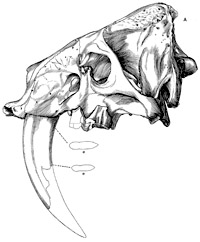Museum, University of Nebraska State
Date of this Version
5-1934
Document Type
Article
Citation
Bulletin of the Nebraska State Museum 1:38 (1934), pp 299-302
Abstract
On February 9, 1934, a pair of rhinoceroses, Trigonias osborni, was installed in the Founder's Room in Morrill Hall, the Nebraska State Museum. They are figured and accorded brief consideration here in order to maintain the printed records of such acquisitions in the Nebraska State Museum. The two skeletons, carefully posed, were put in the south wall case to be associated with a pair of Diceratherium from Morrill County. and the mounted skeletons of two Brown County Te leo ceras. In this gallery two long built-in wall cases insure ample facilities for the proper installation of six rhinoceroses, for each wall case is 45 feet long, nine feet high, and six feet deep. The two skeletons of Trigonias were secured in the Chadron (Lower Oligocene) of Weld County, Colorado, and were given to the Morrill Palaeontological Collections of the Nebraska State Museum by Director J. D. Figgins of the Colorado Museum of Natural History in exchange for a skeleton of Bison occidentalis. The Weld County quarries are located 23 miles northeast of New Raymer, and 14 miles north of Stoneham, in Township 10 north, Range 57 West, Sections 26 and 27, at an altitude of 5,000 feet. Trigonias was amongst the first of the true rhinoceroses. It was a primitive, hornless, long-skulled (dolichocephalic) form, with the front feet functionally four-toed (tetradactyl). In size and general appearance Trigoni.as was much like Subhyracodon tridadylum of tp.e later Protoceras beds. Subhyracodon was formerly known as Aceratherium and Caenopv,s, names which have become pretty well established amongst collectors in this region.
Included in
Entomology Commons, Geology Commons, Geomorphology Commons, Other Ecology and Evolutionary Biology Commons, Paleobiology Commons, Paleontology Commons, Sedimentology Commons


Comments
Copyright © 1934 The Nebraska State Museum